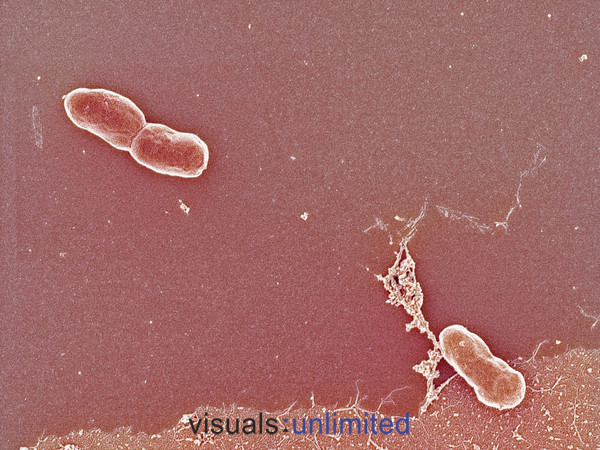Vibrio mimicus
Classification
Higher order taxa
Domain (Bacteria); Phylum (Proteobacteria); Class (Gammaproteobacteria); Order (Vibrionales); Family (Vibrionaceae); Genus (Vibrio)
Species
Vibrio mimicus
Description and significance
Vibrio mimicus are Gram-negative rods characteristically curved or comma shape bacteria [9]. Vibrio mimicus produce colonies of 2 to 3 mm in diameter on blood agar, and colonies on thiosulphate citrate bile salt sucrose (TCBS) are of green color [9]. Vibrio mimicus are facultative anaerobes and possess a single polar flagellum for movements, and are oxidase-positive [9]. V. mimicus are found in aquatic ecosystem, including seawater, freshwater, and brackish water, where it has been found both as a free-living bacterium and in association with zooplankton, crustaceans, filter-feeding mollusks, turtle eggs, and fish [2, 5, 6, 7, and 8]. Vibrio mimicus are responsible for gastroenteritis and are closely related phylogenetically to Vibrio cholerae. The ingestion of raw or uncooked seafood containing Vibrio mimicus can cause gastroenteritis and diarrhea [2]. Phenotypically, most of the features of V. mimicus are similar to V. cholerae, and the main trait differentiating them biologically is sucrose fermentation [4].
Genome structure
Vibrio mimicus strain MB451 genome consists of two circular chromosomes of 2,971,217 bp and 1,304,309 bp with an average guanine-plus-cytosine (G+C) content of 46% and 45%, respectively, and a plasmid of 37,927 bp. The genome sequence for chromosome II (C-II) of V. mimicus MB451 has been completed and closed, whereas chromosome I (C-I) is in a single contig but are not closed, because of a gap of ca. 3.5–4.0 kb, most likely a part of an rDNA repeat [10]. In V. mimicus, chromosome I predominantly contains genes necessary for growth and viability, whereas chromosome II (C-II) bears genes for adaptation to environmental change [10].
Cell and colony structure
Vibrio mimicus is a Gram-negative rod shape bacteria that produces colonies of 2 to 3 mm in diameter on blood agar, and green colonies on thiosulphate citrate bile salt sucrose (TCBS) [9]. Vibrio mimicus are facultative anaerobes and possess a single polar flagellum for movements, and are oxidase-positive [9].
Metabolism
Vibrio mimicus is found to use facultative anaerobic metabolism and are capable of fermenting D-glucose. Also, Vibrio mimicus are oxidase positive, can reduce nitrate to nitrite, requires Na+ for growth, and ferments D-frutose, maltose, and glycerol [9].
Ecology
Vibrio mimicus is a Gram-negative bacterium that is an indigenous member of diverse aquatic environments, including seawater, freshwater, and brackish water, where it has been found both as a free-living bacterium and in association with zooplankton, crustaceans, filter-feeding mollusks, turtle eggs, and fish. [2, 5, 6, 7, and 8]. Research has shown that V. mimicus forms commensalistic symbiotic relationships with Acanthamoeba castellanii (free-living amoebae), where A. castellanii helps in the growth and survival of V. mimicus and protects the intracellular bacteria from antibiotic effects [11].
Pathology
Vibrio mimicus has been associated with diarrhea and gastroenteritis in humans after consumption of raw sea food and shellfish [2]. In V. mimicus, many of the hypothesized virulence factors have been identified including cholera-like enterotoxin, heat-stable enterotoxin, heat-labile enterotoxin, hemolysin, protease, phospholipase, arylesterase, siderophore (aerobactin), and hemagglutinin, while the mechanism of its pathogenesis remains unclear [12].
References
1. Abd, Hadi, Soni Priya Valeru, Susan Marouf Sami, Saumya Raychaudhuri, and Gunnar Sandström. "Identification and Characterization of a Vibrio Mimicus Gene Encoding the Heme/hemoglobin Receptor - Tanabe - 2010 - Microbiology and Immunology." Wiley Online Library. 20 Jan. 2010. Web. 09 Feb. 2012. <http://onlinelibrary.wiley.com/doi/10.1111/j.1348-0421.2010.00256.x/full>.
2. Chowdhury MA, Yamanaka H, Miyoshi S, Aziz KM, Shinoda S. Ecology of Vibrio mimicus in aquatic environments. Appl Environ Microbiol. 1989 Aug;55(8):2073-8.Erratum in: Appl Environ Microbiol 1990 Feb;56(2):581. PubMed PMID: 2782878;PubMed Central PMCID: PMC203005.
3. Chitov T, Kirikaew P, Yungyune P, Ruengprapan N, Sontikun K. An incidence oflarge foodborne outbreak associated with Vibrio mimicus. Eur J Clin MicrobiolInfect Dis. 2009 Apr;28(4):421-4. Epub 2008 Oct 17. PubMed PMID: 18925423.
4. Vieira, Verônica V., Luiz Fernando M. M. Teixeira, Ana Carolina P. Vicente, Carlos André Salles, and Hooman Momen. "Differentiation of Environmental and Clinical Isolates of Vibrio Mimicus from Vibrio Cholerae by Multilocus Enzyme Electrophoresis." Applied and Environmental Microbiology. American Society for Microbiology, 20 Feb. 2001. Web. 09 Feb. 2012. <http://aem.asm.org/content/67/5/2360.full>.
5. Chowdhury MA, Aziz KM, Kay BA, Rahim Z (1987) Toxin production by Vibrio mimicus strains isolated from human and environmental sources in Bangladesh. J Clin Microbiol 25:2200–2203.
6. Colwell RR, Huq A (1994) Environmental reservoir of Vibrio cholerae. The causative agent of cholera. Disease in Evolution: Global Changes and Emergence of Infectious Diseases, eds Wilson ME, Levins R, Spielman A (Ann. New York Acad. Sci, New York), Vol 740, pp 44–54.
7. Campos E, et al. (1996) Vibrio mimicus diarrhea following ingestion of raw turtle eggs. Appl Environ Microbiol 62:1141–1144.
8. Shi L, et al. (1998) Detection of genes encoding cholera toxin (CT), zonula occludens toxin (ZOT), accessory cholera enterotoxin (ACE) and heat-stable enterotoxin (ST) in Vibrio mimicus clinical strains. Microbiol Immunol 42:823–828.
9. ‘IDENTIFICATION OF VIBRIO SPECIES’ Health Protection Agency (HPA). Issue no: 2 Issue date: 12.11.07 Issued by: Standards Unit, Evaluations and Standards Laboratory. Reference no: BSOP ID 19i2 http://www.hpastandardmethods.org.uk/documents/bsopid/pdf/bsopid19.pdf
10. Hasan et al. 10.1073/pnas.1013825107. http://www.pnas.org/content/suppl/2010/11/12/1013825107.DCSupplemental/pnas.201013825SI.pdf#nameddest=SF1.
11. Aba, Hadi, Soni Priya Valeru, Susan Marouf Sami, Amir Saeed, Saumya Raychaudhuri, and Gunnar Sandström. "Interaction between Vibrio Mimicus and Acanthamoeba Castellanii." Environ Microbiol Rep 2.1 (2010): 166-71. PubMed Central. 24 Nov. 2009. Web. 26 Apr. 2012. <http://www.ncbi.nlm.nih.gov/pmc/articles/PMC2861843/?report=abstract>. doi: 10.1111/j.1758-2229.2009.00129.x
12. Hasan NA, Grim CJ, Haley BJ, Chun J, Alam M, Taviani E, Hoq M, Munk AC, Saunders E, Brettin TS, Bruce DC, Challacombe JF, Detter JC, Han CS, Xie G, Nair GB, Huq A, Colwell RR. Comparative genomics of clinical and environmental Vibrio mimicus. Proc Natl Acad Sci U S A. 2010 Dec 7;107(49):21134-9. Epub 2010 Nov 15. doi: 10.1073/pnas.1013825107
Edited by Raj Patel, Student of Dr. Lisa R Moore, University of Southern Maine

